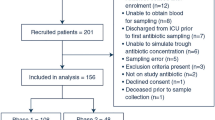Abstract
Arbekacin (ABK) is an aminoglycoside and widely used in Japan for treatment of patients infected with methicillin-resistant Staphylococcus aureus (MRSA). Although, ABK has concentration-dependent antibacterial activity, the peak serum concentration (C peak) of ABK has not yet been fully investigated as an indicator of the efficacy of ABK. The present study was conducted in patients admitted to hospitals affiliated with the ABK Dose Finding Study Group, between October 2008 and June 2011, who had pneumonia or sepsis, the cause of which was identified or suspected to be MRSA. The initial target C peak was set at 15–20 μg/mL and therapeutic drug monitoring was conducted. Then the relationship between serum concentration and efficacy/safety of ABK was prospectively examined to obtain sufficient clinical efficacy. In total, 89 patients from 11 clinical sites in Japan were enrolled and 29 of these patients were subjected to efficacy analysis. The mean initial dose and C peak were 306.9 mg/day and 16.2 μg/mL, respectively. The efficacy rate was 95 % (19/20 patients) at 5–6 mg/kg or higher, 87.5 % (7/8) for sepsis and 90.5 % (19/21) for pneumonia, and the overall efficacy rate was 89.7 % (26/29). There was no increase in the incidence of adverse events. In conclusion, we recommend the initial dose of ABK at 5–6 mg/kg or higher and the dosage regimen should be adjusted to achieve C peak at 10–15 μg/mL or higher in the treatment of patients with pneumonia or sepsis caused by MRSA. This strategy would surely achieve low incidence of adverse events while obtaining high clinical efficacy.



Similar content being viewed by others
References
Totsuka K, Shimizu K, Mitomi N, Niizato T, Araake M. Evaluation of once-daily administration of arbekacin. Experimental study and determination of pharmacokinetic properties in man. Jpn J Antibiot. 1994;47:676–92.
Niijima T. New antimicrobial agent series XL: arbekacin. Jpn J Antibiot. 1991;44:705–17.
Meiji Seika Pharma Co., Ltd. Package insert of Habekacin® Injection, version 7, 2011.
Tanikaze N, Komatsu M, Shimakawa K, Yamamoto I. Study of clinical significance of PK/PD (pharmacokinetic/pharmacodynamic) parameters after administering arbekacin to patients with pulmonary methicillin-resistant Staphylococcus aureus infection. Jpn J Chemother. 2004;52:469–73.
Aikawa N, Kohno S, Kaku M, Watanabe A, Yamaguchi K, Tanigawara Y. An open clinical study of arbekacin 200 mg q.d. in patients infected with methicillin-resistant Staphylococcus aureus (MRSA)—a clinical pharmacology study. Jpn J Chemother. 2008;56:299–312.
Begg EJ, Barclay ML, Kirkpatrick CM. The therapeutic monitoring of antimicrobial agents. Br J Clin Pharmacol. 2001;52(Suppl 1):35S–43S.
Sawchuk RJ, Zaske DE, Cipolle RJ, Wargin WA, Strate RG. Kinetic model for gentamicin dosing with the use of individual patient parameters. Clin Pharmacol Ther. 1977;21:362–9.
Demczar DJ, Nafziger AN, Bertino JS Jr. Pharmacokinetics of gentamicin at traditional versus high doses: implications for once-daily aminoglycoside dosing. Antimicrob Agents Chemother. 1997;41:1115–9.
Kobayashi M, Takesue Y, Tanigawara Y, Mikamo H, Kimura T, Hirata S, et al. Therapeutic drug monitoring survey of anti-MRSA agents in Japan. Jpn J Chemother. 2010;58:119–24.
Cockcroft DW, Gault MH. Prediction of creatinine clearance from serum creatinine. Nephron. 1976;16:31–41.
Sato N, Miura Y, Mitomi N, Hayashi H, Suzuki H, Shibasaki S, et al. Population pharmacokinetic analysis of arbekacin sulfate in adult patients. Jpn J Ther Drug Monit. 2010;27:98–110.
Kimura T, Sunakawa K, Totsuka K, Matsumoto T, Hanaki H, Soma K, et al. Dose finding study on arbekacin sulfate for appropriate peak levels. Jpn J Chemother. 2011;59:597–604.
Ferreira FL, Bota DP, Bross A, Melot C, Vincent J-L. Serial evaluation of the SOFA score to predict outcome in critically ill patients. JAMA. 2001;286(14):1754–8.
The Japanese Respiratory Society. The committee for the JRS guidelines in management of respiratory infections: the JRS guidelines for the management of hospital-acquired pneumonia in adults. Kyorin-sha: Tokyo; 2008; p. 4.
Kawano H, Tanigawara Y. Postmarketing surveillance review of arbekacin sulfate in patients with therapeutic drug monitoring. Jpn J Ther Drug Monit. 2010;27:55–71.
Hwang JH, Lee JH, Moon MK, Kim JS, Won KS, Lee CS. The usefulness of arbekacin compared to vancomycin. Eur J Clin Microbiol Infect Dis. 2012;31:1663–6.
Fowler VG Jr, Boucher HW, Corey GR, Abrutyn E, Karchmer AW, Rupp ME, et al. Daptomycin versus standard therapy for bacteremia and endocarditis caused by Staphylococcus aureus. N Engl J Med. 2006;355:653–65.
Yamamoto Y, Iumikawa K, Hashiguchi K, Kakeya H, Yanagihara K, Kohno S, et al. The efficacy and safety of high-dose arbekacin sulfate therapy (once-daily treatment) in patients with MRSA infection. J Infect Chemother. 2012;18:241–6.
Acknowledgments
We sincerely acknowledge the doctors who enrolled patients for the investigation. The 11 clinical sites affiliated to the ABK Dose Finding Study Group were as follows (in alphabetical order according to the Japanese Syllabary): Kitasato University Hospital, Kitasato University Kitasato Institute Hospital, Saitama Medical University International Medical Center, Chiba University Hospital, Teikyo University School of Medicine University Hospital, Teikyo University School of Medicine University Hospital, Mizonokuchi, Tokyo Medical University Hospital, Hachioji Medical Center of Tokyo Medical University, Dokkyo Medical University, Koshigaya Hospital, Nippon Medical School Hospital, Nihon Koukan Hospital.
Conflict of interest
Tetsuya Matsumoto has received lectures including service on speakers bureaus, and Keisuke Sunakawa has research grant for other research than study from Meiji Seika pharma Co., Ltd. No other co-authors declare any conflict of interest in this study.
Author information
Authors and Affiliations
Consortia
Corresponding author
Additional information
The work should be attributed to the ABK Dose Finding Study Group.
About this article
Cite this article
Matsumoto, T., Hanaki, H., Kimura, T. et al. Clinical efficacy and safety of arbekacin sulfate in patients with MRSA sepsis or pneumonia: a multi-institutional study. J Infect Chemother 19, 128–137 (2013). https://doi.org/10.1007/s10156-012-0519-z
Received:
Accepted:
Published:
Issue Date:
DOI: https://doi.org/10.1007/s10156-012-0519-z




